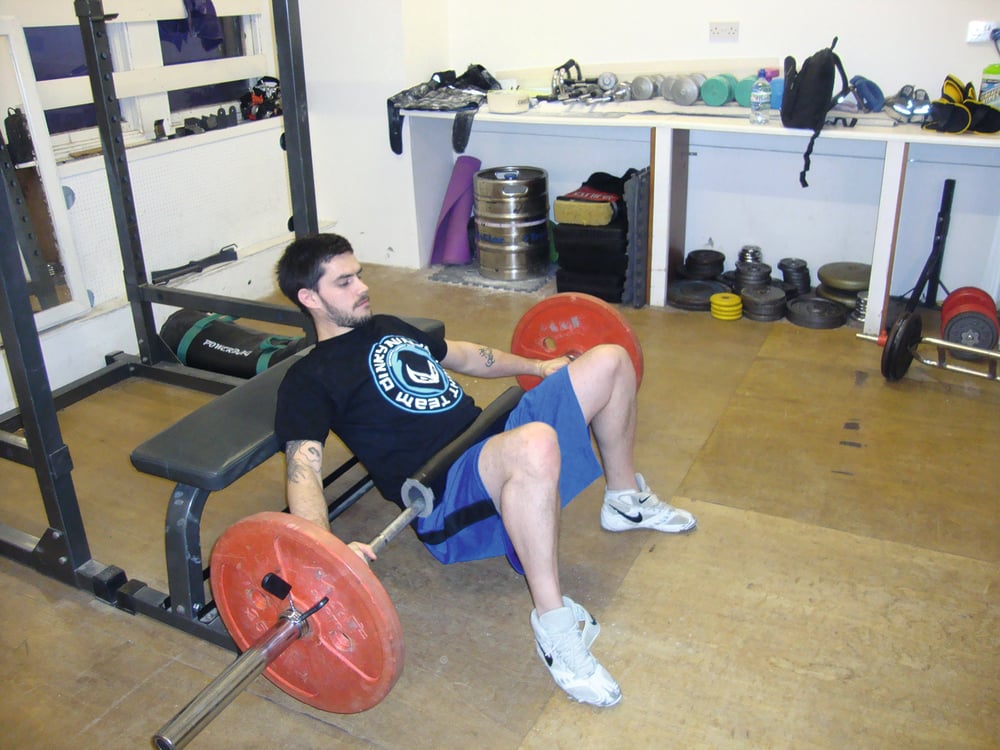
Issue 074
April 2011
Paul McVeigh is a sports scientist and a professional fighter ranked as the number one bantamweight in Europe. He trains fighters out of The Griphouse gym in Glasgow, Scotland. Get in touch with Paul via [email protected].
Regular readers of this column will be familiar with the idea of glute activation. I bang on about this so much that it borders on the creepy. So why are glutes so important? The butt muscles are big players when it comes to athletic performance. They are involved in most striking techniques and takedowns, finishing submissions plus tonnes of the other stuff that makes up an MMA bout. In the case of glutes bigger and stronger is definitely better. A combat sports athlete can never have glutes that are too strong. As well as improving sporting performance stronger glutes will also aid in the prevention of injuries to the lower back, hamstrings, knees and groin.
The Problem With Your Usual Warm-Up
So you’re probably warming up with glute activation exercises by performing lots of squat, deadlift and lunge variations. Bases covered, right? Unfortunately your glutes may not be as strong as you think. A really smart guy called Brett Contreras hooked some electrodes to a lot of people and did some experiments to find out which exercises brought about the greatest muscular activity in the glutes. Despite being freaking awesome for a lot of other stuff, squats and dead lifts are not going to make Sir Mix-a-Lot of Baby Got Back fame take notice. Even walking lunges – which are notorious for causing glute soreness – only produce a 30% maximum voluntary contraction. The problem with everyone’s favorite compound exercises is that the quadriceps, erector spinae and hamstrings take the brunt of the loading.
...And The Solution
So that scientist, Mr Contreas, went and invented a bunch of great exercise designed to bring about maximum voluntary contraction of the glute muscles. One of them I like the most is the barbell hip thrust, as it’s effective, easy to coach, requires minimal equipment and is stupidly safe. It’s now become one of our program mainstays.
Getting Started With The Barbell Hip Toss
As with all exercises you have to earn the right to do it. If you just try to replicate the movement while having a movement problem you will be cementing that dysfunction and possibly increase the likelihood of an injury developing.
Firstly to get the most out of any hip extension or hip hyperextension movement, we need to ensure that hip flexors are not stiff. If the hip flexors are stiff full hip flexion is inhibited and the involvement of the glute musculature is reduced. Sixty-second hip flexor stretches added into your warm ups for a few weeks should rectify the situation. So add in some glute activation in the form of bridges and you’re set. A few weeks of high rep (ten to twenty) barbell glute bridges is also a good precursor to the hip thrust exercise. This is the same as the barbell hip thrust (see below) but in this case the shoulders aren’t elevated. It’s an easier version and a good regression if the full barbell hip thrust is too challenging.
The next stage is to perform the hip thrust with bodyweight. This allows the coach to see if complete hip extension has taken place. At the top of the movement you should be able to draw a straight line between your shoulder and the knee that intersects your hip. If the line takes a dip at the hips, extension has not been completed.
When doing the barbell hip thrust you should use a squat pad. Having a 150kg of iron bar pressed into your pelvis can get pretty funky. The pad makes a thoroughly uncomfortable exercise a lot more fun.

Performing the Barbell Hip Thrust
Place a bench against a squat rack or wall so the bench doesn’t move, and load a barbell. Remember the squat pad.
Sit on the floor with your back against the bench. Roll the barbell over your legs until it is in line with the top of your thighs.
Raise your knees and place your feet flat on the floor. Elevate your shoulders onto the bench and secure the bar with your hands.
Drive with your hips in a controlled motion and concentrate on squeezing your glutes at the top of the lift.
Lower under control and begin your next rep.
The two most common errors when performing this lift are incomplete hip hyperextension and jerking the movement. To rectify both at my gym, the Griphouse, we begin our athletes with a one-to-three second isometric hold at the top of the lift. This allows the coaches to clearly see the final position and ensure full hip hyper extension has taken place without excessive lumbar extension. If you feel this exercise mostly in your lower back you’re doing it wrong. This protocol also stops guys hip thrusting like Bonobo apes.
...










